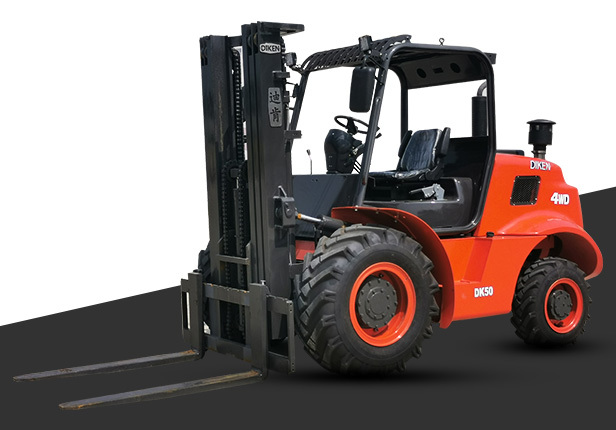Diken news
Rough Terrain Forklifts vs. Standard Forklifts: Key Differences Explained for Optimal Material Handling
Release time: 2025-07-22
Rough Terrain Forklifts vs. Standard Forklifts: Key Differences Explained
Introduction to Forklift Types
In the world of material handling, **forklifts** play a crucial role in enhancing efficiency. Two commonly used types are **rough terrain forklifts** and **standard forklifts**. Understanding the **key differences** between these models is essential for making an informed choice that aligns with your operational needs. This article delves deep into the characteristics, advantages, and best applications for each type of forklift.
What are Standard Forklifts?
Standard forklifts are designed for use in warehouses and paved surfaces. They come in various weight capacities and are equipped with powerful engines and hydraulic systems to lift heavy loads. These forklifts are ideal for tasks such as stacking, loading, and unloading goods in controlled environments.
Features of Standard Forklifts
1. Design and Build
Standard forklifts typically have a compact design, making them easy to maneuver in tight spaces. The smaller turning radius allows for efficient operation in warehouses with narrow aisles.
2. Load Capacity
These forklifts generally boast load capacities ranging from 3,000 to 15,000 pounds. They excel in lifting heavy pallets and industrial materials, making them suitable for a variety of industries.
3. Fuel Options
Standard forklifts can be powered by electricity, propane, or diesel, providing flexibility in fuel choice based on operational needs and preferences.
What are Rough Terrain Forklifts?
Rough terrain forklifts, on the other hand, are specifically engineered for outdoor use, particularly on uneven surfaces. They are commonly used in construction sites, landscaping, and agricultural applications, where terrain challenges require specialized equipment.
Features of Rough Terrain Forklifts
1. Heavy-Duty Tires
Rough terrain forklifts come equipped with oversized, rugged tires designed to provide superior traction on soft, muddy, or uneven ground. This feature allows for smooth operation in conditions where standard forklifts would struggle.
2. Elevated Ground Clearance
With a higher ground clearance, rough terrain forklifts can easily navigate obstacles such as rocks, ditches, and other imperfections in the ground. This design minimizes the risk of damage to the forklift's undercarriage.
3. Versatile Load Handling
These forklifts typically feature extendable booms that allow for versatile load handling at various heights, making them ideal for lifting loads over obstacles or into elevated areas.
Key Differences Between Rough Terrain Forklifts and Standard Forklifts
1. Terrain Adaptability
One of the most significant differences lies in terrain adaptability. Standard forklifts perform best on smooth, flat surfaces, while rough terrain forklifts are designed to tackle uneven ground, mud, and gravel with ease.
2. Load Capacity and Reach
While standard forklifts generally handle heavier loads, rough terrain forklifts may have specialized attachments that allow them to lift loads higher, making them more versatile in challenging environments.
3. Cost Considerations
Typically, rough terrain forklifts come with a higher price tag due to their specialized features. However, the investment may be justified if your operations require consistent outdoor use.
4. Maintenance Requirements
Standard forklifts require less frequent maintenance compared to rough terrain models, which may need more extensive care due to their exposure to harsh environments.
5. Safety Features
Safety is paramount in material handling. Rough terrain forklifts are equipped with advanced safety features, such as stability systems and rollover protection, to ensure safe operation on uneven surfaces.
Applications of Rough Terrain Forklifts
Rough terrain forklifts are indispensable in various sectors. Here are some common applications:
1. Construction Sites
In construction, these forklifts are employed to move materials such as bricks, cement, and heavy machinery across uneven terrain.
2. Landscaping
Landscapers utilize rough terrain forklifts to transport materials like soil, rocks, and plants, especially in areas with challenging access.
3. Agricultural Use
Farmers rely on these forklifts for heavy lifting and transporting goods across fields, particularly during harvest season.
Applications of Standard Forklifts
Standard forklifts serve a broad range of applications in more controlled environments:
1. Warehousing
In warehouses, standard forklifts efficiently handle the movement of pallets, goods, and inventory, ensuring streamlined operations.
2. Retail Distribution Centers
They're essential for managing bulk inventory in retail distribution centers, where quick access and organized storage are critical.
3. Manufacturing Facilities
Manufacturers utilize standard forklifts to move raw materials and finished products throughout the production process, enhancing workflow efficiency.
Choosing the Right Forklift for Your Operations
When selecting between rough terrain and standard forklifts, consider the following factors:
1. Terrain Conditions
Evaluate the typical conditions of your operational site. If your work involves uneven landscapes, a rough terrain forklift is likely the better choice.
2. Load Requirements
Assess the weight and dimensions of the loads you regularly handle. This will help you determine the appropriate load capacity and lift height needed.
3. Frequency of Use
Consider how often the forklift will be used. High-frequency operations may warrant investing in a more versatile rough terrain model, while occasional use in a controlled environment may suffice with a standard forklift.
4. Budget Constraints
Factor in both initial purchase costs and ongoing maintenance expenses to make a financially sound decision.
Frequently Asked Questions (FAQs)
1. Can rough terrain forklifts operate on smooth surfaces?
Yes, rough terrain forklifts can operate on smooth surfaces, but they may not be as efficient as standard forklifts in those conditions.
2. How do I maintain my forklift for optimal performance?
Regular maintenance, including checking fluid levels, inspecting tires, and ensuring hydraulic systems are functioning, is essential for both types of forklifts.
3. Are there any attachments available for rough terrain forklifts?
Yes, various attachments, including forks, buckets, and booms, can enhance the versatility of rough terrain forklifts.
4. What is the average lifespan of a forklift?
The average lifespan of a forklift can range from 7 to 15 years, depending on usage and maintenance practices.
5. Is operator training required for forklift use?
Yes, proper training is essential for all forklift operators to ensure safety and compliance with regulations.
Conclusion
In summary, understanding the differences between rough terrain forklifts and standard forklifts is crucial for optimizing your material handling operations. Each type of forklift has its unique advantages and applications, making it vital to assess your specific needs. By considering factors such as terrain conditions, load requirements, and budget constraints, you can make a well-informed decision that enhances efficiency and productivity in your business. Whether you require the rugged adaptability of a rough terrain forklift or the precision of a standard forklift, informed choices lead to enhanced operational success.
Keywords: rough terrain forklift









